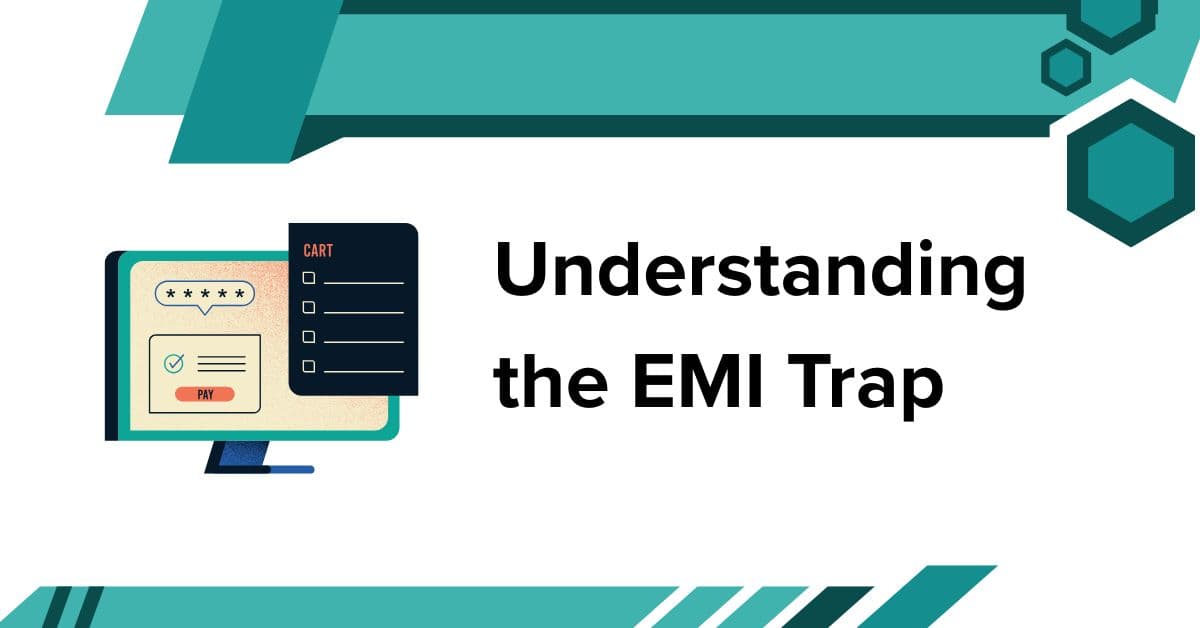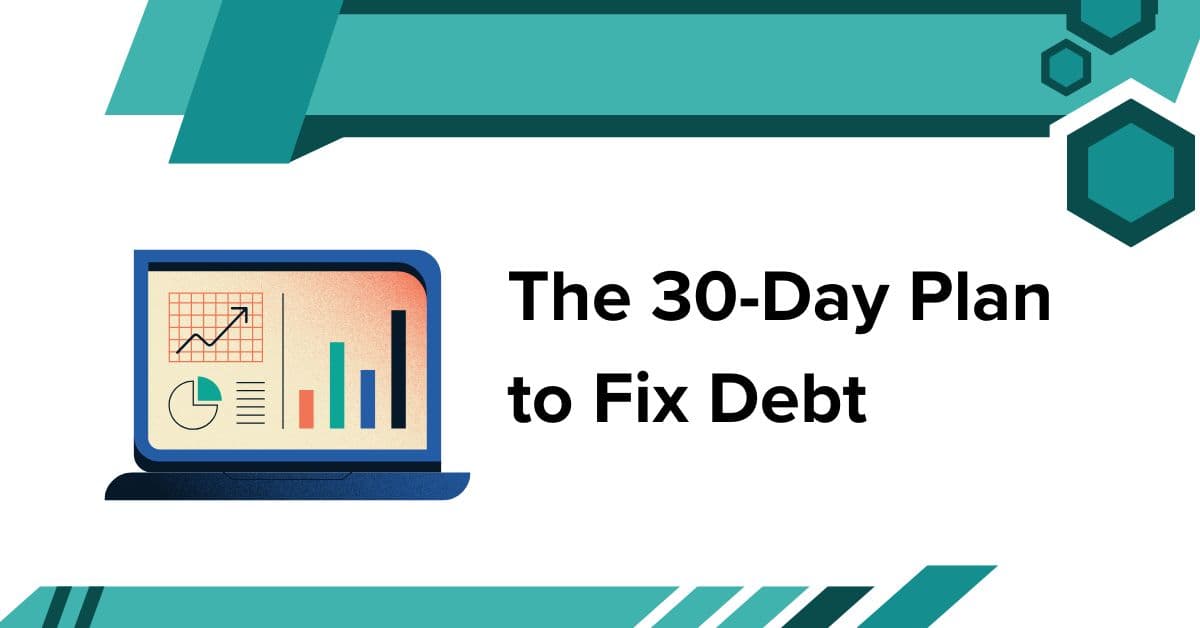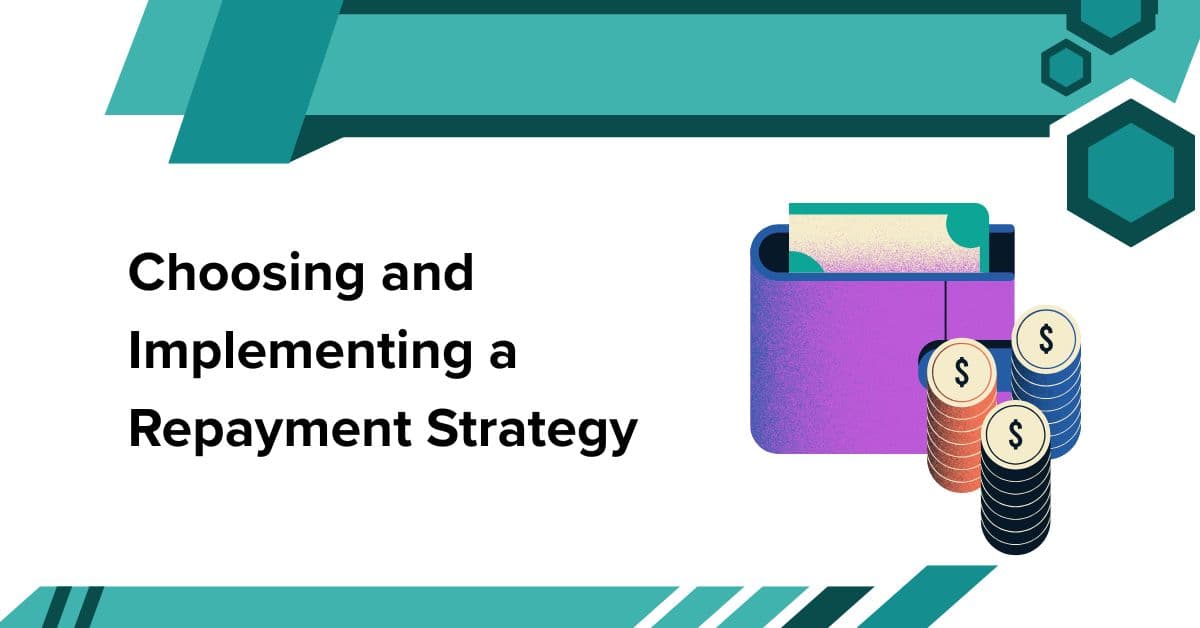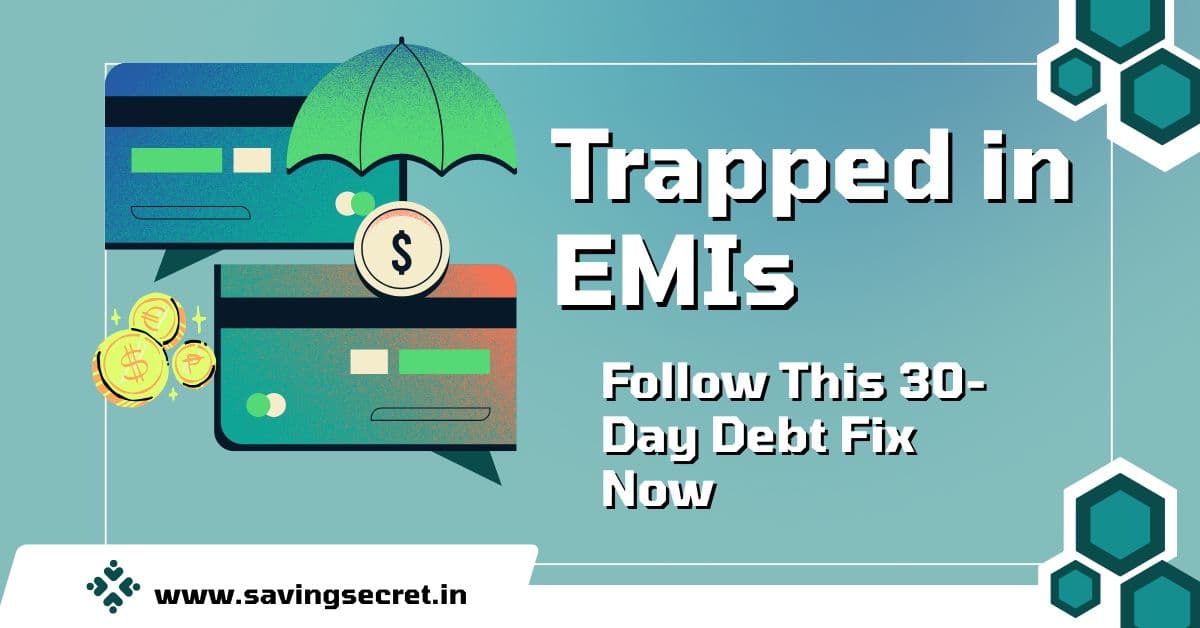Trapped in EMIs? Are you feeling overburdened by several Equated Monthly Instalments (EMIs) for credit card debt, personal loans, auto loans, or house loans? It’s not just you. With 35% of borrowers skipping payments in 2025 owing to financial hardship, maintaining EMIs may put a burden on budgets in India, where middle-class households frequently juggle multiple loans (NCFE Survey). High interest rates might make you feel like you’re stuck in a debt cycle. Credit card interest rates range from 20% to 40%, while personal loan interest rates range from 10% to 20%. Written specifically for Indian households, this 30-day debt fix plan provides a methodical way to evaluate your debts, make a budget, prioritise repayments, and establish long-lasting financial practices. By doing these actions, you may lessen the stress caused by EMIs, save between ₹1,000 and ₹5,000 per month, and eventually achieve financial independence.
Understanding the EMI Trap
Principal and interest are combined into fixed monthly loan payments known as Equated Monthly Instalments (EMIs). In India, EMIs are typical for house loans (8–10% interest), auto loans (9–12%), and personal loans (10–20%). When many payments overlap, they might become problematic. According to a 2025 survey, 20% of Indian borrowers have trouble managing their debt since they have several EMIs, which can result in late fines, harm to their credit score, and financial stress (Financial Express). Overborrowing can result from the ease of acquiring loans from NBFCs like (Bajaj Finance) or banks like (HDFC Bank). This is particularly true when paired with high-interest credit card debt.

Why You Feel Trapped?
- Multiple EMIs: It might be difficult to keep track of many due dates and amounts, which raises the possibility of missing payments.
- High Interest Rates: It might be challenging to lower principal on credit cards and personal loans due to their high interest rates.
- Limited Disposable Income: When EMIs take up more than 40% of income, there is little left over for emergencies or savings.
- Late Fees and Penalties: Failure to make payments on time results in penalties (between ₹200 and ₹800 each EMI) and possible harm to one’s credit score.
This 30-day strategy uses Indian financial tools and tactics to streamline EMI management while addressing these issues with concrete actions.
The 30-Day Plan to Fix Debt
Each of the four weeks in this plan focusses on a different important facet of debt management. You may significantly lower your EMI load by committing to daily or weekly chores.

Week 1: Make a Budget and Evaluate Your Debt (Days 1–7)
Day 1–3: Make a list of all your debts
Compile information about all of your credit card and loan amounts first. Include:
- Loan Type: Credit card, personal loan, auto loan, home loan, etc.
- Lender: such as Axis Bank, SBI, or HDFC Bank.
- Outstanding Balance: The whole amount remained.
- Interest Rate: The annual rate, such as 36% for credit cards and 8.5% for house loans.
- EMI: A set monthly payment amount.
- Date of Due: The due date for each payment.
To arrange this data, use a notepad or a spreadsheet. For example:
Effectively managing several loans is essential to preserving financial stability. The borrower currently has four outstanding credit commitments. With an interest rate of 8.5% and a monthly EMI of ₹25,000 payable on the fifth of each month, the HDFC Bank house loan has an outstanding amount of ₹25,000,000. The ICICI Bank auto loan is for ₹5,00,000, with a 9.0% interest rate and a ₹10,000 monthly EMI that is due on the 10th. Furthermore, there is a ₹2,00,000 outstanding debt on an SBI personal loan with a 12.0% interest rate and a ₹5,000 monthly EMI that is due on the 15th. Last but not least, an Axis Bank credit card shows a ₹50,000 amount at a high interest rate of 36.0%, with a minimum payment of ₹2,500 due on the twentieth of every month. Maintaining a good credit score and avoiding late penalties require keeping up with interest rates and EMI due dates.
Day 4-5: Calculate Total Debt and Payments
To determine your debt burden, add up all of your outstanding bills and monthly EMIs. Regarding the aforementioned example:
- ₹25,000,000 + ₹5,00,000 + ₹2,00,000 + ₹50,000 = ₹32,50,000 is the total outstanding balance.
- Monthly EMI total: ₹42,500 (₹25,000 + ₹10,000 + ₹5,000).
Compare this to the amount you make each month. EMIs take up 70.83% of your income if you make ₹60,000, which is far higher than the advised 40% and indicates that something needs to be done.
Days 6–7: Establish a spending plan
To find money for debt repayment, keep track of your earnings and outlays. To classify expenditure, use programs such as [Money View] or [Walnut]:
- Income sources include side jobs, rent, and salary.
- Rent, insurance, and EMIs are examples of fixed costs.
- Entertainment, utilities, and groceries are examples of variable costs.
Use the rule of 50/30/20:
- 50% (₹30,000) goes towards necessities (rent, EMIs).
- 30% (₹18,000) goes towards desires (subscriptions, meals).
- 20% (₹12,000) goes towards debt payments and savings.
Determine where you can make savings, such as cutting back on eating out or terminating subscriptions, to free up ₹2,000 to ₹5,000 per month for debt payback.
Week 2: Choosing and Implementing a Repayment Strategy (Days 8-14)
Days 8–10: Recognise Debt Repayment Strategies
Decide on a plan to give EMI payments priority:

- Bill Snowball: For rapid victories, pay off the lowest bill first (such as a ₹50,000 credit card), then go to greater debts. [Art of Manliness] This increases motivation.
- Debt Avalanche: To save money on interest, pay off the debt with the highest interest rate first (such as a 36% credit card), then work on bills with lesser interest rates [NerdWallet]. Due to high credit card charges, this is sometimes more economical for Indian borrowers.
- Debt Consolidation: Pay off several debts with a single loan at a reduced interest rate, making payments easier. For instance, a 36% credit card debt might be paid off with a 12% personal loan from [Bajaj Finance] [Financial Express].
The debt avalanche is optimal for the aforementioned situation, giving priority to the 36% credit card debt.
Days 11-14: Implementing the Strategy
Pay the minimal amount owed on all bills, with the exception of the priority debt, for which you should set aside more cash. Regarding the ₹50,000 credit card with 36% interest:
- Make ₹4,500 a month by paying the minimum of ₹2,500 plus an additional ₹2,000 from budget reduction.
- Continue making the ₹40,000 minimum payments on your other EMIs.
For an estimate of interest savings and payback schedules, use a [EMI calculator].
Week 3: Reduce Spending and Increase Revenue (Days 15–21)
Days 15–18: Cut Down on Spending
Examine your spending plan to reduce unnecessary expenses:
- Groceries: Save ₹500 to ₹1,000 per month by purchasing in bulk from [JioMart] or local markets.
- Utilities: Save between ₹200 and ₹500 by using energy-efficient equipment and paying your bills using [Paytm] to receive cashback.
- Transportation: Use public transportation or carpool with [Quick Ride] to save between ₹500 and ₹2,000.
- Subscriptions: Save ₹200 to ₹600 by cancelling unneeded gym or streaming memberships.
- Eating Out: Save ₹300 to ₹1,000 by cooking at home.
For debt repayment, try to set aside 10–20% of your costs, or ₹2,000–₹5,000 for a ₹60,000 salary.
Days 19–21: Increase Revenue
Investigate secondary sources of income to accelerate debt repayment:
- Freelancing: Earn between ₹5,000 and ₹10,000 per month by offering your writing or design services on [Upwork] or [Fiverr]
- Sell Unused Items: To get ₹1,000 to ₹5,000, sell electronics or furniture via [OLX] or [Quikr].
- Part-Time Work: Earn an extra ₹2,000 to ₹5,000 per month by taking up delivery or coaching duties.
- Rent Out Space: You may make between ₹5,000 and ₹15,000 a month by listing a spare room on [Airbnb].
High-interest debt may be greatly reduced with just ₹2,000 more per month.
Week 4: Track Progress and Automate Payments (Days 22–30)

Days 22–25: Automate EMI Payments
To prevent late fines (₹200 to ₹800 per missed payment) and to safeguard your credit score [RupeeQ], set up auto-debit for EMIs using the site of your bank or lender (for example, [HDFC Bank] or [SBI]. Set autopay for at least the minimum amount owed on credit cards.
Days 26–28: Track Performance
Every week, update your debt list to track any decreases. On the ₹50,000 credit card, for instance, a monthly payment of ₹4,500 lowers the balance to about ₹46,000 by day thirty. To keep motivated, celebrate little victories and visualise your progress using a spreadsheet or [Money View].
Days 29–30: Make adjustments and make plans
Examine your plan and make any necessary adjustments. Try the snowball approach if the debt avalanche isn’t inspiring you. Make long-term plans:
- Continue cutting costs and creating a budget.
- Avoid additional loans unless absolutely necessary.
- To avoid future debt, save an emergency fund equal to three to six months’ worth of spending.
Frequently Askes Questions (FAQs)
Why does it feel like EMIs are a trap?
Budgets may be strained by several EMIs with high interest rates and overlapping due dates, which may result in late payments and penalties.
What is the most effective way to pay off debt?
The snowball approach provides faster psychological gains, while the debt avalanche saves more interest. Make a decision based on your reasons.
Is debt consolidation appropriate for all people?
Securing a cheaper interest rate is advantageous, but longer loan periods might raise overall expenses. To assess, use an EMI calculator.
How can I make sure I don’t miss my EMIs?
Use the site of your bank or lender to set up auto-debit, and set up reminders with applications like [Paytm].
What happens if I am unable to pay additional fees?
For information on restructuring possibilities or short-term relief, get in touch with your lender, such as [Bajaj Finance].
An Example from Real Life
Situation: Arjun, a 35-year-old Mumbai professional who makes ₹60,000 a month, has ₹42,500 in EMIs (credit card: ₹2,500, personal loan: ₹5,000, auto loan: ₹10,000, and house loan: ₹25,000).
Week 1: Compiles a list of bills, determines the total amount owed (₹32.5 lakh), and makes a budget, reducing subscriptions and eating expenses by ₹3,000.
Week 2: Decides on debt avalanche, paying ₹4,500 a month on the 36% credit card till day 30, which brings the total down to ₹46,000.
Week 3: Adds to debt payments by earning ₹5,000 from freelancing on [Upwork] and saving ₹1,500 via carpooling.
Week 4: Uses [HDFC Bank] to automate EMIs and [Money View] to monitor progress.
Result: Lessens financial stress by reducing credit card debt by ₹4,000, saving ₹4,500 per month, and aiming to pay it off in around ten months.
Conclusion
It’s normal to feel stuck by EMIs, but this 30-day debt-fix strategy gives Indian families the power to take charge. You can reduce financial stress and save ₹1,000 to ₹5,000 per month by evaluating your debts, creating a budget, giving high-interest EMIs priority, reducing spending, and automating payments. To keep organised, use programs like [Money View] or [Paytm]; for more complicated situations, get advice from a financial expert. To escape the EMI trap and create a stable financial future, get started right now!
Disclaimer: Everybody manages debt differently. Before making decisions, get advice from a financial professional.
karnataka Bank Share Price & Debt Stress? Act Now
Buy Now Pay Later Can Trap You in Debt: Here’s What No One Tells You
Accenture Share Price is Rising: Manage Debt Before You Miss Out!

